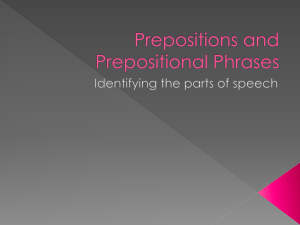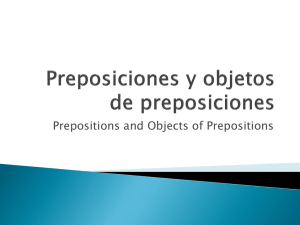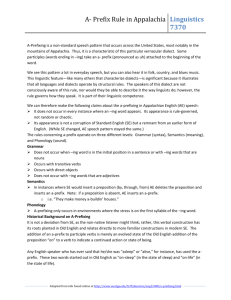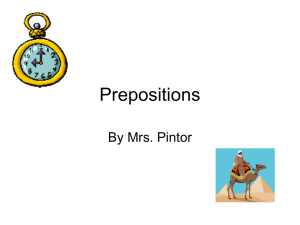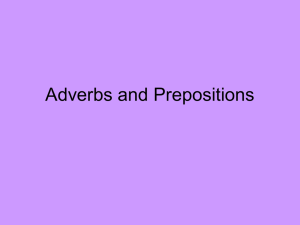AN ANALYSIS OF STUDENTS` ERRORS IN USING THE ENGLISH
advertisement
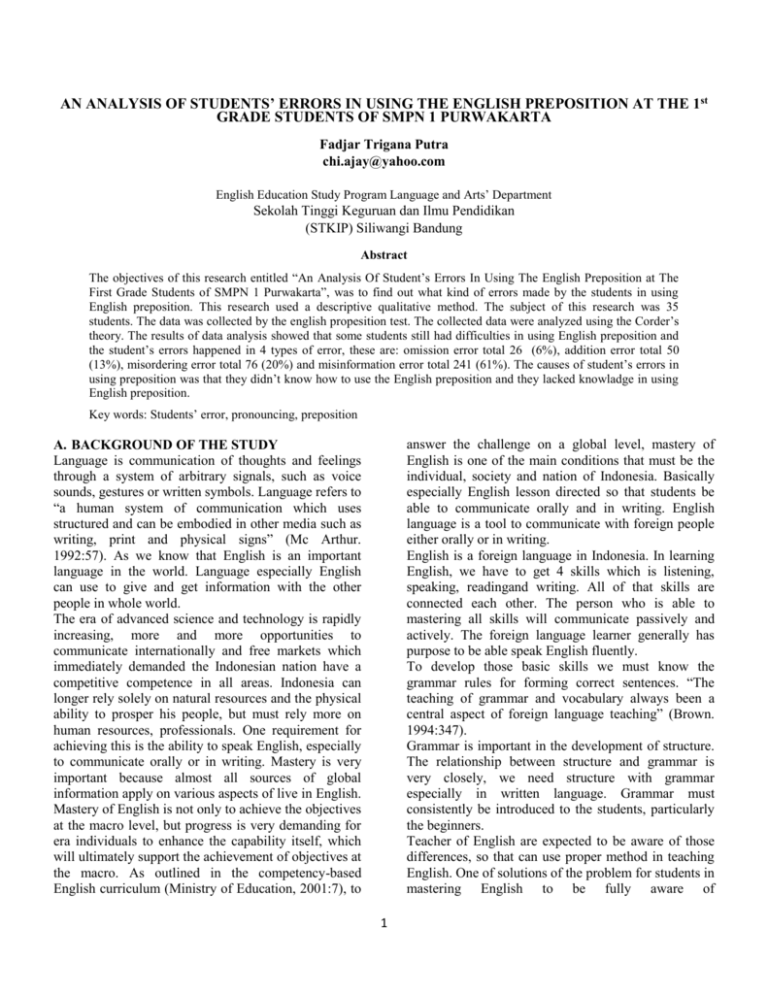
AN ANALYSIS OF STUDENTS’ ERRORS IN USING THE ENGLISH PREPOSITION AT THE 1st GRADE STUDENTS OF SMPN 1 PURWAKARTA Fadjar Trigana Putra chi.ajay@yahoo.com English Education Study Program Language and Arts’ Department Sekolah Tinggi Keguruan dan Ilmu Pendidikan (STKIP) Siliwangi Bandung Abstract The objectives of this research entitled “An Analysis Of Student’s Errors In Using The English Preposition at The First Grade Students of SMPN 1 Purwakarta”, was to find out what kind of errors made by the students in using English preposition. This research used a descriptive qualitative method. The subject of this research was 35 students. The data was collected by the english propesition test. The collected data were analyzed using the Corder’s theory. The results of data analysis showed that some students still had difficulties in using English preposition and the student’s errors happened in 4 types of error, these are: omission error total 26 (6%), addition error total 50 (13%), misordering error total 76 (20%) and misinformation error total 241 (61%). The causes of student’s errors in using preposition was that they didn’t know how to use the English preposition and they lacked knowladge in using English preposition. Key words: Students’ error, pronouncing, preposition answer the challenge on a global level, mastery of English is one of the main conditions that must be the individual, society and nation of Indonesia. Basically especially English lesson directed so that students be able to communicate orally and in writing. English language is a tool to communicate with foreign people either orally or in writing. English is a foreign language in Indonesia. In learning English, we have to get 4 skills which is listening, speaking, readingand writing. All of that skills are connected each other. The person who is able to mastering all skills will communicate passively and actively. The foreign language learner generally has purpose to be able speak English fluently. To develop those basic skills we must know the grammar rules for forming correct sentences. “The teaching of grammar and vocabulary always been a central aspect of foreign language teaching” (Brown. 1994:347). Grammar is important in the development of structure. The relationship between structure and grammar is very closely, we need structure with grammar especially in written language. Grammar must consistently be introduced to the students, particularly the beginners. Teacher of English are expected to be aware of those differences, so that can use proper method in teaching English. One of solutions of the problem for students in mastering English to be fully aware of A. BACKGROUND OF THE STUDY Language is communication of thoughts and feelings through a system of arbitrary signals, such as voice sounds, gestures or written symbols. Language refers to “a human system of communication which uses structured and can be embodied in other media such as writing, print and physical signs” (Mc Arthur. 1992:57). As we know that English is an important language in the world. Language especially English can use to give and get information with the other people in whole world. The era of advanced science and technology is rapidly increasing, more and more opportunities to communicate internationally and free markets which immediately demanded the Indonesian nation have a competitive competence in all areas. Indonesia can longer rely solely on natural resources and the physical ability to prosper his people, but must rely more on human resources, professionals. One requirement for achieving this is the ability to speak English, especially to communicate orally or in writing. Mastery is very important because almost all sources of global information apply on various aspects of live in English. Mastery of English is not only to achieve the objectives at the macro level, but progress is very demanding for era individuals to enhance the capability itself, which will ultimately support the achievement of objectives at the macro. As outlined in the competency-based English curriculum (Ministry of Education, 2001:7), to 1 difficulties being faced. Encountered by primary school students is among others, the used preposition. Based of the data obtained the writer, the students will make mistake in doing homework, doing exercise, etc. according the dictionary of linguistics errors analysis in language teaching and testing a technique of a measuring progress by recording and classifying the mistakes made by individual or group of students. B. THEORETICAL FOUNDATION A. Teaching Grammar Most people agree that knowing a language means among other things, knowing its grammar. It necessarily that grammar and structure need to be taught or formal rules need to be learned. When applying communicative language teaching (CLT), teacher understands that the goal of language teaching is communicative competence. One of components of communicative competence is grammatical competence. Based on this, student should learn grammar as it is suggested by the 1994 curriculum, that grammar should be thought in context not isolation. Rutherford (1980) in Nunan (1991: 154) suggested that “the development of some pedagogical grammars involves the principles selection of items which reflect pedagogical experience as well as linguistic theory”. Say the several book have been published and these book talk about the place of grammar in the curriculum. It is said that grammar should be taught in communicative context. Teaching grammar in context means teaching grammar based on the way teaching which is not the traditional one, when teacher provides the grammatical rules and the explanation of rules. Student are expected to be more communicative and can find out the grammar rules by themselves. Teacher plays the role as the imitator, the motivator and the helpers whenever their students need. Other techniques for teaching grammar will be provided in the following lines. The techniques are from McKay’s (1985) in Brown (2001: 368-373). She define the five technique for teaching grammar which are relevant to the teaching of grammar in context the technique are as follow: The writer agrees to practice grammar in context as it is will motivate the teacher to be more creative. Based on 1994 syllabus for teaching English creative teachers are needed to improve students capability in English. B. Preposition 1. Definition of preposition The preposition is classified as a part of speech in traditional grammar. However, preposition as well as conjunction differ from other parts of speech in that (1) each composed of a small class of word that have no formal characteristic endings; (2) each signals syntactic structures that function as one of the other parts of speech. For these reason modern linguistic prefer to classify preposition as structure word rather than as parts of speech. According to Hornby (1995: 911) “Preposition is a word or group of word used before a noun or pronoun to show place, position, time or method”. Based on the statement above the writer can include that preposition if a word as changed in its form and usually is put in frontto show the relation with the other word. 2. Type of Preposition Based on “Comprehensive Grammar of the English language” there are two form of preposition: simple preposition and complex preposition. a) Simple preposition consist of one word 1) Monosyllabic preposition As, at, but, by, down, for, from, in, like, near, of, off, on, out, past, round, since, than, through, till, to, up, with. 2) Polysylabic preposition About, above, across, after, against, along, among, around, before, behind, beside, between, beyond, during, expert, inside, into, onto, opposite, over, pending, under, until, unlike, upon, within. b) A complex preposition A complex preposition is sequences that is indivisible both in term of syntax and in terms of meaning. In + noun + of, In + noun + with,By + noun + of,On + noun + of, At + noun + of. 1. 2. 3. 3. a. 1) 2) b. 4. 5. Teaching grammar by using a chart Teaching grammar by using object Teaching grammar by using maps and other simple drawing Teaching grammar by using dialogue Teaching grammar by using written texts 2 Prepositional meaning Prepositional denoting spatial relation Dimension Relative Position Preposition Denoting Time – target language utterance. Such ways include: omission, addition, misinformation and misordering. a. Omission errors are characterized by the absenceof an item that must appear in a well-formed utterance. Although any morpheme or word in a sentence is a potential candidate for omission, some types or morpheme are omitted more than others. Language learners omit grammatical morphemes (e.g. is, the, of, etc) much more frequently than content morphemes or word (e.g. nouns, verbs adverbs, adjectives). Omission errors are found in greater abundance and across a greater variety of morpheme the early stages of SLA (Second Language Acquisition). b. Addition errors are the opposite of omission. They are characterized by the presence of an item which must not appear in a well-formed utterance. Addition errors have three types there are : double marking, regularization and simple addition. c. Misinformation errors are characterized by use of the wrong form of the morpheme or structure. d. Misordering errors are characterized by the incorrect placement of morpheme or group of morphemes in an utterance. For example in the utterance “he is all the time late”. 2. Explaining Errors Where the purpose of errors analysis help learners to learn an L2, there is a need to evaluate errors. Some errors can be considered more serious than other because they are more likely to interfere with the intelligibility of what someone says. Teachers should focus their attention on these. Errors analysis may be used as well as instead of contrasted analysis. A learners error provide evidence of the system of the language that he is using (has learned) at a particular popint in the course. The making of errors then is strategy employed both by the children acquiring their mother tongue and by those learning a second languge. In learning preposition, students are sometimes difficult to use it because they do not understand to placing the appropriate preposition, not only that but some of the problem with preposition: 1. They are difficult to define without using other preposition. 2. They do not have equivalent meanings in other languages. 3. Two or more preposition may have the same meaning and sometimes they are interchangeable and sometimes not. A prepositional phrase of time usually occurs as adjunct predication adjunct. Time Position : at, on in, by. At, on and in, as preposition of “time position” are to some extent parallel to the same items as positive preposition of position. C. The Meaning of Errors Analysis Student often make mistakes in doing a test, doing a homework, doing exercise, etc. according to the dictionary linguistics “Errors Analysis in language teaching and testing a technique of measuring progress by recording and classifying the mistake made by individual or group of students. Programmed instruction aims at avoiding the production of error. Although many linguists and psychologists claim that error necessary in the gradual acquisition of a language. In foreign language teaching, error analysis can be supplemented by constructive analysis to measure degree of interference between source and target language” (Harman and Stark, 1976: 78) The teacher of second language came to realize that the mistake or error person made by the process of constructing a new system of language needed to be analyzed carefully. Mistake must be carefully distinguished from errors. An error is a fault which result from incomplete knowledge. In other words, an error is a systematic deviation due to the learner’s still developing knowledge of the SL rule system or an error is a competence-based deviation. According to the book language acquisition by Kaswan (2010:49) Studying learner’s error serves two major purposes. 1. It provides data from which inferences about the bature of the language learning process can be made. 2. It indicates to the teachers and curriculum developers which part of the target language students have most difficulty producing correctly and which types of error detract most from a learners abilities to communicate effectively. D. Procedures Error Analysis 1. Identifying Errors The first step in the process of analysis is the identification and description of errors. Once all the errors have been identified, they can be described and classified. There are several ways of doing this. One way is to classify errors into grammatical categories, another way might be to try to identify general ways in which the learners utterences differ from reconstructed 3 4. Many prepositions are used in expression where their meaning is very different from what might be expected. 5. A preposition in combination with another word may have different meanings. In learning preposition the teacher ust be creative on using method. Picture can make students understand the lesson of preposition. In order that the student understand more about using preposition and they make no and media. To teach preposition the teacher can give examples from daily activities which the students do or from action which really happen or we can use C. RESEARCH METHODOLOGY 1. Research Method There were two kinds of research which were commonly used in educational research. They were qualitative and quantitative research. Based on objective and the problem of research, the writer decided to use qualitative method. Qualitative method is a method which used to analyze the condition of the natural object, where the researcher is the key instrument. Qualitative research is collects the data through observation and then comes up with a theory account or the data. The theories can explain the data collected or facts which are observed (Moleong, 1995:2-7). In this research, the writer conducted descriptive qualitative research. So, the writer analyzed students’ errors in using English preposition at the first(1st) grade students of SMPN 1 Purwakarta. 2. Instrument of the Research a. Method of Collecting Data Data has very important role in research, because without data, it is impossible to get result of the research. To obtain the data, the research has to use instrument of collecting data, they are: observation, interview and document. Maxwell (1996: 127) said classroom participant observation, student's interviews and teacher’s interviews are the primary sources (method) of data collection. 1) Data Investigation The force of the result of data investigation depends on the procedures of the research itself. Before the analysis of the data given, it was important that the procedure of the research is described. 2) Document Document is a kind of source data involves anything notes aimed to examine a research. (Moleong. 1995: 161). In a research, the Researcher may use syllabus, teaching material, lesson plan, and recording interview as the document. b. Technique for analyzing data In this research, the writer conducts descriptive qualitative research which analyzing the errors made by students in using preposition. The follows are the procedures of analyzing the data. 3. Population and Sample 1. Population Population are groups consisting of all people to whom researcher wish to apply his/her finding (Crowl, 1996:8). The population of this study was the first grade students of SMP Negeri 1 Purwakarta 2. Sample Samples are subsets of people used to represent population (Crowl, 1996:8). The sample of this study was 35 students of VII A. 4. Object of The Research The object of the research is the errors made by students in using preposition in English. 5. Data Source In this research the data were the classroom activities, classroom observation, teaching-learning process and test to the students. The writer also took data source from primary data and secondary data. Primary data are taken from classroom observation, teaching-learning process, test the students, problem solving used by the teacher to solve the students’ problem and documents. Secondary data are taken from the books related to the problem and from the literature of the data. 6. Research Procedure In the research, the writer did the following things: a. The writer began her research on… b. The data collected from the first grade as the sample c. After the data collected, they were processed and analyzed by using the percentage of the correct and wrong answer. D. FINDINGS AND DISCUSSIONS 1. Data Analysis As stated before, in this research, the writer tried to answer the following questions what kinds of errors are made by the students in using the preposition made by first grade students of SMPN 1 Puwakarta. The writer would like to put the students’ scores on the tables in order to know how many errors that the students’ made. There are 35 students and 25 test items. In the table below, the writer would like to 4 compare between the students correct answer and students errors. The Instruments showed some students still had difficulties in using English preposition. It approved that the students made 19 correct answers (55%) from 25 items and made 16 wrong answers (45%) from 25 items. The writer likes to analyze the type of errors that the student made. As stated before there are four kind of errors in using English preposition, they are: omission errors, addition errors, misordering errors, and misinformation errors. Accordingly the writer would divide the errors into 4 types in order to find out what kind of errors they made. The analysis would be explained in table now. 2. Discussions From the data analyzed, the writer found some student still had difficulties in using English preposition. It proves that the students made 19 correct answers (55%) from 25 items and made 16 wrong answers (45%) from 25 items. 1. Omission Errors Here is omission errors that happen (6%), some students are still not recognizing the words of preposition. for example, students were told to be circled all the worlds which include the prepositions but they only do some of prepositions. “The ducks in front of me swam in the lake”. Some of students answer “The ducks in front of me swam in the lake” this answer is error because the students were missing. He/she should have answered “The ducks in front of me swam in the lake”. 2. Addition Error This is the students’ additional error (13%). Some students make some words which are not supposed to be there. For the example: have difficulties to differ which one is preposition and which one is not a preposition. For example: “The Cup is on the table” The students’ answer: “The Cup is on the table” The word that is supposed to be circled and include the preposition word is “The Cup is on the table”. 4. Misinformation Error Most of the students didn’t know how to use preposition or they have lack of knowledge in using English preposition. For example: E. CONCLUSIONS AND SUGESSTION 1. The Conclusions From all description given in the previous chapter, the writer has come to the following conclusions: 1. The students made many errors in using the English prepositions. It is proved by the result of the test that average students made 16 errors (45%) from 25 item tests. 2. Based on the data from the test, the writer concludes that the students’ error that mostly occur is in misinformation error (61%). This means that the most of the student did not understand how to use English preposition. Some students also made errors in omission error (6%), and addition error (13%). It means that they have difficulties in distinguishing engllish preposition the other words and they are loosing some words which is do not exist and make some incorrect words. They also made error in misordering error (20%) which means that they still make mistakes to place a preposition. 2. The Suggestions As the final part of the paper, the writer would like to propose several suggestions as follows: 1. The teacher should actually know and understand the use of English preposition. 2. To reach the goal of mastering the use of English preposition by the students, the teacher should motivate them, to give the materials and correct their mistakes and errors at the right moment. 3. In order to be successful in learning English, the school has to prepare some facilities such as English book, and visual aids which are needed by them. 4. The English teachers should pay more attention to her/ his common forms of errors that the students made, especially in using English preposition which are encountered by the first grade of SMPN 1 Purwakarta. 5. The teacher should find the teaching techniques and method which are suitable for the The ball is ……… the net. Students’ answer: The ball is on at the net. Students should know that the correct answer is “The ball is on the net”. Students shouldn’t add “at” after “on”. 3. Misordering Error The writer found 20 % of errors occurred in this type of error. It means that some students made the incorrect placement of preposition. in this error, the students still 5 students demand and more effective and efficient in the teaching learning process. 6. The students need to practice in increasing their English ability especially in using the English preposition. F. BIBLIOGRAPHY Nunan, David. 1991. Language Teaching Methodology a textbook for teacher. USA: Prentice Hall International Jack, Richard C. 1980. Eroors Analysis, Perspective on Second Language Acquisition. London: Longman Group Limited H.Douglas Brown. 2001. Theaching by Principles: an interactive approach to language pedagogy. USA: Prentice-Hall.inc Quirk, Randolph, and Greenbaum, Sydney et al. 1985. A Comprehensive Grammar of English Language. New York: Longman.inc Raymond, Murphy. 1989. English in Use. Cambridge: University Press 6

